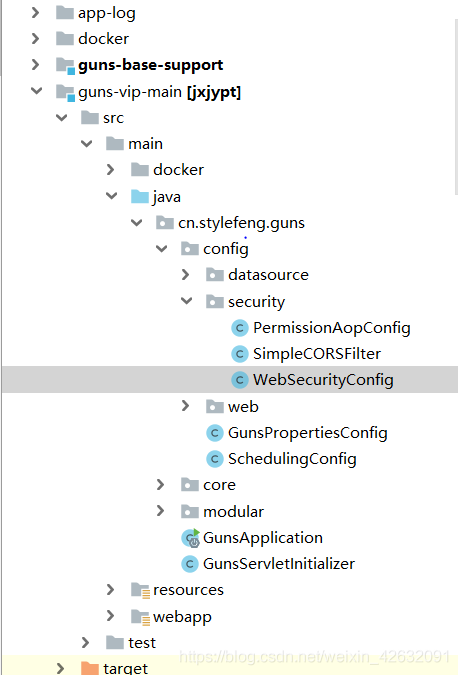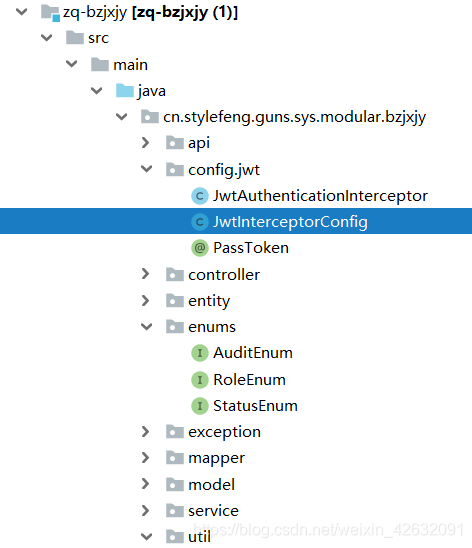Java的接口调用时的权限验证功能的实现
提示:这里可以添加本文要记录的大概内容:
例如:一般系统前端调用后台相关功能接口时,需要验证此时用户的权限是否满足调用该接口的条件,因此我们需要配置相应的验证权限的功能。
提示:以下是本篇文章正文内容,下面案例可供参考
一、编写的环境
工具:IDEA
框架:GUNS框架(自带后台权限验证配置,我们这里需要编写前端权限验证配置)
二、使用步骤
1.配置前端调用的接口
代码如下(示例):

在WebSecurityConfig中:
// 登录接口放开过滤
.antMatchers("/login").permitAll()
// session登录失效之后的跳转
.antMatchers("/global/sessionError").permitAll()
// 图片预览 头像
.antMatchers("/system/preview/*").permitAll()
// 错误页面的接口
.antMatchers("/error").permitAll()
.antMatchers("/global/error").permitAll()
// 测试多数据源的接口,可以去掉
.antMatchers("/tran/**").permitAll()
//获取租户列表的接口
.antMatchers("/tenantInfo/listTenants").permitAll()
//微信公众号接入
.antMatchers("/weChat/**").permitAll()
//微信公众号接入
.antMatchers("/file/**").permitAll()
//前端调用接口
.antMatchers("/api/**").permitAll()
.anyRequest().authenticated();
加入前端调用接口请求地址:
.antMatchers("/api/**").permitAll()
添加后前端所有/api的请求都会被拦截,不会直接调用相应接口
2.配置拦截路径
代码如下(示例):

在创建文件JwtlnterceptorConfig:
package cn.stylefeng.guns.sys.modular.bzjxjy.config.jwt;
import org.springframework.context.annotation.Bean;
import org.springframework.context.annotation.Configuration;
import org.springframework.web.servlet.HandlerInterceptor;
import org.springframework.web.servlet.config.annotation.InterceptorRegistry;
import org.springframework.web.servlet.config.annotation.WebMvcConfigurer;
@Configuration
public class JwtInterceptorConfig implements WebMvcConfigurer {
@Override
public void addInterceptors(InterceptorRegistry registry) {
//默认拦截所有路径
registry.addInterceptor(authenticationInterceptor())
.addPathPatterns("/api/**")
;
}
@Bean
public HandlerInterceptor authenticationInterceptor() {
return new JwtAuthenticationInterceptor();
}
}
3.创建验证文件
创建文件JwtAuthenticationInterceptor,代码如下(示例):
package cn.stylefeng.guns.sys.modular.bzjxjy.config.jwt;
import cn.stylefeng.guns.sys.modular.bzjxjy.entity.Student;
import cn.stylefeng.guns.sys.modular.bzjxjy.entity.TopTeacher;
import cn.stylefeng.guns.sys.modular.bzjxjy.enums.RoleEnum;
import cn.stylefeng.guns.sys.modular.bzjxjy.enums.StatusEnum;
import cn.stylefeng.guns.sys.modular.bzjxjy.exception.NeedToLogin;
import cn.stylefeng.guns.sys.modular.bzjxjy.exception.UserNotExist;
import cn.stylefeng.guns.sys.modular.bzjxjy.service.StudentService;
import cn.stylefeng.guns.sys.modular.bzjxjy.service.TopTeacherService;
import cn.stylefeng.guns.sys.modular.bzjxjy.util.JwtUtils;
import org.springframework.beans.factory.annotation.Autowired;
import org.springframework.web.method.HandlerMethod;
import org.springframework.web.servlet.HandlerInterceptor;
import org.springframework.web.servlet.ModelAndView;
import javax.servlet.http.HttpServletRequest;
import javax.servlet.http.HttpServletResponse;
import java.lang.reflect.Method;
/**
* jwt验证
* @author Administrator
*/
public class JwtAuthenticationInterceptor implements HandlerInterceptor {
@Autowired
private TopTeacherService topTeacherService;
@Autowired
private StudentService studentService;
@Override
public boolean preHandle(HttpServletRequest httpServletRequest, HttpServletResponse httpServletResponse, Object object) throws Exception {
// 如果不是映射到方法直接通过
if (!(object instanceof HandlerMethod)) {
return true;
}
HandlerMethod handlerMethod = (HandlerMethod) object;
Method method = handlerMethod.getMethod();
//检查是否有passtoken注释,有则跳过认证
if (method.isAnnotationPresent(PassToken.class)) {
PassToken passToken = method.getAnnotation(PassToken.class);
if (passToken.required()) {
return true;
}
}
//默认全部检查
else {
// 执行认证
Object token1 = httpServletRequest.getSession().getAttribute("token");
if (token1 == null) {
//这里其实是登录失效,没token了 这个错误也是我自定义的,读者需要自己修改
httpServletResponse.sendError(401,"未登录");
throw new NeedToLogin();
}
String token = token1.toString();
//获取载荷内容
String type = JwtUtils.getClaimByName(token, "type").asString();
String id = JwtUtils.getClaimByName(token, "id").asString();
String name = JwtUtils.getClaimByName(token, "name").asString();
String idNumber = JwtUtils.getClaimByName(token, "idNumber").asString();
//判断当前为名师
if (RoleEnum.TOP_TEACHER.equals(type)){
//检查用户是否存在
TopTeacher topTeacher = topTeacherService.getById(id);
if (topTeacher == null || topTeacher.getStatus().equals(StatusEnum.FORBIDDEN)) {
httpServletResponse.sendError(203,"非法操作");
//这个错误也是我自定义的
throw new UserNotExist();
}
//学生
}else {
//需要检查用户是否存在
Student user = studentService.getById(id);
if (user == null || user.getStatus().equals(StatusEnum.FORBIDDEN)) {
httpServletResponse.sendError(203,"非法操作");
//这个错误也是我自定义的
throw new UserNotExist();
}
}
// 验证 token
JwtUtils.verifyToken(token, id);
//放入attribute以便后面调用
httpServletRequest.setAttribute("type", type);
httpServletRequest.setAttribute("id", id);
httpServletRequest.setAttribute("name", name);
httpServletRequest.setAttribute("idNumber", idNumber);
return true;
}
return true;
}
@Override
public void postHandle(HttpServletRequest httpServletRequest,
HttpServletResponse httpServletResponse,
Object o, ModelAndView modelAndView) throws Exception {
}
@Override
public void afterCompletion(HttpServletRequest httpServletRequest,
HttpServletResponse httpServletResponse,
Object o, Exception e) throws Exception {
}
}
文件中有个string类型的token,这个token是用户登录时在controller里创建的,具体代码加在用户登陆的接口里:
String token = JwtUtils.createToken(topTeacher.getId(), RoleEnum.TOP_TEACHER,topTeacher.getName(),idNumber);
request.getSession().setAttribute("token",token);
4.创建注解@PassToken
package cn.stylefeng.guns.sys.modular.bzjxjy.config.jwt;
import java.lang.annotation.ElementType;
import java.lang.annotation.Retention;
import java.lang.annotation.RetentionPolicy;
import java.lang.annotation.Target;
/**
* 在方法上加入本注解 即可跳过登录验证 比如登录
* @author Administrator
*/
@Target({ElementType.METHOD, ElementType.TYPE})
@Retention(RetentionPolicy.RUNTIME)
public @interface PassToken {
boolean required() default true;
}
总结
提示:这里对文章进行总结:
以上就是完整的编写一个前端页面调用控制器接口时,进行验证判断相应权限的代码实现。主要是针对guns框架写的,因为guns框架本来自带接口权限验证功能,只不过只是针对后台而已,我在这里添加了针对前端的权限验证,仅供参考。
到此这篇关于Java的接口调用时的权限验证功能的实现的文章就介绍到这了,更多相关Java 接口调用时权限验证内容请搜索猪先飞以前的文章或继续浏览下面的相关文章希望大家以后多多支持猪先飞!
相关文章
- 这篇文章主要介绍了如何利用java语言实现经典《复杂迷宫》游戏,文中采用了swing技术进行了界面化处理,感兴趣的小伙伴可以动手试一试...2022-02-01
java 运行报错has been compiled by a more recent version of the Java Runtime
java 运行报错has been compiled by a more recent version of the Java Runtime (class file version 54.0)...2021-04-01- 这篇文章主要介绍了在java中获取List集合中最大的日期时间操作,具有很好的参考价值,希望对大家有所帮助。一起跟随小编过来看看吧...2020-08-15
- 这篇文章主要介绍了教你怎么用Java获取国家法定节假日,文中有非常详细的代码示例,对正在学习java的小伙伴们有非常好的帮助,需要的朋友可以参考下...2021-04-23
- 这篇文章主要介绍了Java如何发起http请求的实现,文中通过示例代码介绍的非常详细,对大家的学习或者工作具有一定的参考学习价值,需要的朋友们下面随着小编来一起学习学习吧...2021-03-31
- 说起C#和Java这两门语言(语法,数据类型 等),个人以为,大概有90%以上的相似,甚至可以认为几乎一样。但是在工作中,我也发现了一些细微的差别...2020-06-25
- 这篇文章主要介绍了解决Java处理HTTP请求超时的问题,具有很好的参考价值,希望对大家有所帮助。一起跟随小编过来看看吧...2021-03-29
- 这篇文章主要介绍了java 判断两个时间段是否重叠的案例,具有很好的参考价值,希望对大家有所帮助。一起跟随小编过来看看吧...2020-08-15
- 这篇文章主要介绍了超简洁java实现双色球若干注随机号码生成(实例代码),本文通过实例代码给大家介绍的非常详细,对大家的学习或工作具有一定的参考借鉴价值,需要的朋友可以参考下...2021-04-02
java 画pdf用itext调整表格宽度、自定义各个列宽的方法
这篇文章主要介绍了java 画pdf用itext调整表格宽度、自定义各个列宽的方法,具有很好的参考价值,希望对大家有所帮助。一起跟随小编过来看看吧...2021-01-31- 这篇文章主要介绍了Java生成随机姓名、性别和年龄的实现示例,文中通过示例代码介绍的非常详细,对大家的学习或者工作具有一定的参考学习价值,需要的朋友们下面随着小编来一起学习学习吧...2020-10-01
- 这篇文章主要介绍了java正则表达式判断前端参数修改表中另一个字段的值,需要的朋友可以参考下...2021-05-07
Java使用ScriptEngine动态执行代码(附Java几种动态执行代码比较)
这篇文章主要介绍了Java使用ScriptEngine动态执行代码,并且分享Java几种动态执行代码比较,需要的朋友可以参考下...2021-04-15- 这篇文章主要介绍了Java开发实现人机猜拳游戏,文中示例代码介绍的非常详细,具有一定的参考价值,感兴趣的小伙伴们可以参考一下...2020-08-03
- 这篇文章主要介绍了Java List集合返回值去掉中括号('[ ]')的操作,具有很好的参考价值,希望对大家有所帮助。一起跟随小编过来看看吧...2020-08-29
Java中lombok的@Builder注解的解析与简单使用详解
这篇文章主要介绍了Java中lombok的@Builder注解的解析与简单使用,本文给大家介绍的非常详细,对大家的学习或工作具有一定的参考借鉴价值,需要的朋友可以参考下...2021-01-06- 下面小编就为大家带来一篇java中String类型变量的赋值问题介绍。小编觉得挺不错的。现在分享给大家,给大家一个参考。...2016-03-28
Java 8 Stream 的终极技巧——Collectors 功能与操作方法详解
这篇文章主要介绍了Java 8 Stream Collectors 功能与操作方法,结合实例形式详细分析了Java 8 Stream Collectors 功能、操作方法及相关注意事项,需要的朋友可以参考下...2020-05-20- 这篇文章主要介绍了Java线程池中的各个参数如何合理设置操作,具有很好的参考价值,希望对大家有所帮助。如有错误或未考虑完全的地方,望不吝赐教...2021-06-19
- 在Java中,我们可以利用多线程来最大化地压榨CPU多核计算的能力,下面这篇文章主要给大家介绍了关于java中多线程与线程池基本使用的相关资料,需要的朋友可以参考下...2021-09-13
